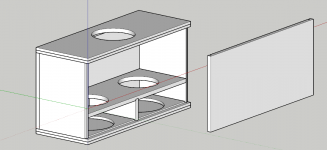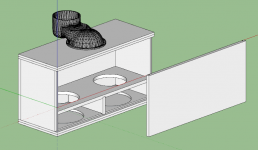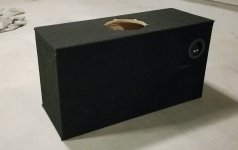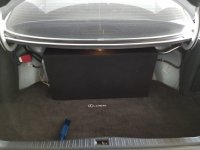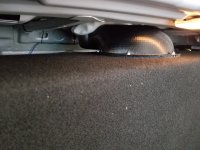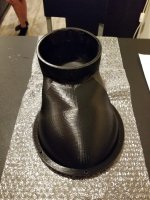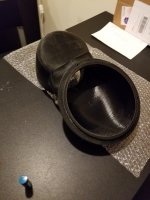Beginner in car audio, really just learning every step of the way.
1999 Lexus LS400 with stock sound system
This car has a really well sealed cab, which is a blessing and a curse. The trunk is very well isolated from the inside of the car and there sits a 20 gallon fuel tank behind the rear seat.
Stock subwoofer is a single 8" on the rear deck mounted in infinite baffle.
Looking to add some nice SQ bass to my car while maintaining the stock head unit and speakers (ideally).
Knowing that the trunk is so well isolated I determined through research that the only real solution was a 4th order bandpass with the port routed through the stock subwoofer opening. This sounded like a great idea so I went with it, but don't have any experience designing enclosures let alone a bandpass.
Through the limited amount of information I could find I started building the following:
Infinity Kappa K1000 mono amp 1000 W RMS @ 2ohm. Speaker level inputs connected to factory amplifier subwoofer output.
2 Infinity Kappa 800W 8" subs 4ohm each wired parallel. Specs:
400W RMS
Fs: 34.5Hz
Qms: 4.0
Qes:0.459
Qts: 0.412
Xmax: 9.25mm
Sensitivity: 89dB
Triple chamber 4th order bandpass enclosure. Specs after driver displacement:
Sealed volume (each): 0.32ft^3, 553in^3, 9.1L
Shared ported chamber volume: 1.28ft^3, 2212in^3, 36.2L
Port: 4" diameter, ~7"length
I designed the enclosure based on the specs provided from the manufacturer for sealed box (used that for the sealed section) then did 2:1 to get the ported section volume. I did not tune the port. I knew this design could end up sounding crappy, but I don't have the knowledge to properly design a bandpass. I really don't want to use a bandpass box, but I am afraid a standard sealed or ported box is going to require a lot more power to get the bass into the car due to the isolated trunk.
This is how the setup sounds:
I like the volume, the bass is nice and loud inside the cab. Bass is tight and hits nice in heavy rock songs with lots of drums; however, it does not sound good on longer bass notes found in hip hop or mostly any other music besides fast drums. It sounds boomy, its difficult to describe, but it doesn't sound great. I liken it to the feeling you get in your ears when you have an exhaust that drones, its uncomfortable. This is mostly on the longer bass notes. I have messed with the gains and crossovers a lot and it made no significant difference. I can hear the "droning" even at low volumes, its just more annoying the louder it is. My research tells me that 4th order bandpass setups are boomy by nature, so I don't know how normal this is. I have nothing to compare it to. I tried stuffing with polyfill and lining with open cell foam. It made little difference. The box is built very well and is air tight.
My question is: is this due to the port being untuned? Is it due to the factory stereo driving the system (possibly clipped, removing low bass notes etc.)? Is it due to the box design? All of the above? I would much rather rebuild this system with a pair of sealed boxes but I am afraid it is not going to be loud enough.
Does anyone have any recommendations for me? Should I try to get the port tuned properly, rebuild the bandpass box, upgrade the head unit, go with different woofers, or go some other route?
I am not aiming for a super loud system, just want good sound quality and bass for mostly pop and some hip hop music. I do prefer loud SQ but of course loud is relative. The volume of the system right now is perfect. I don't want to give up more than about 30"x12"x18" space in my trunk, but I will give up more if I need to. I also do not want to modify the rear deck of the vehicle at all.
Please help me determine what is wrong with my system! I included a screenshot of the enclosure design with the port on top. Feel free to rip me a new one for this design, I just want to get it right eventually.
1999 Lexus LS400 with stock sound system
This car has a really well sealed cab, which is a blessing and a curse. The trunk is very well isolated from the inside of the car and there sits a 20 gallon fuel tank behind the rear seat.
Stock subwoofer is a single 8" on the rear deck mounted in infinite baffle.
Looking to add some nice SQ bass to my car while maintaining the stock head unit and speakers (ideally).
Knowing that the trunk is so well isolated I determined through research that the only real solution was a 4th order bandpass with the port routed through the stock subwoofer opening. This sounded like a great idea so I went with it, but don't have any experience designing enclosures let alone a bandpass.
Through the limited amount of information I could find I started building the following:
Infinity Kappa K1000 mono amp 1000 W RMS @ 2ohm. Speaker level inputs connected to factory amplifier subwoofer output.
2 Infinity Kappa 800W 8" subs 4ohm each wired parallel. Specs:
400W RMS
Fs: 34.5Hz
Qms: 4.0
Qes:0.459
Qts: 0.412
Xmax: 9.25mm
Sensitivity: 89dB
Triple chamber 4th order bandpass enclosure. Specs after driver displacement:
Sealed volume (each): 0.32ft^3, 553in^3, 9.1L
Shared ported chamber volume: 1.28ft^3, 2212in^3, 36.2L
Port: 4" diameter, ~7"length
I designed the enclosure based on the specs provided from the manufacturer for sealed box (used that for the sealed section) then did 2:1 to get the ported section volume. I did not tune the port. I knew this design could end up sounding crappy, but I don't have the knowledge to properly design a bandpass. I really don't want to use a bandpass box, but I am afraid a standard sealed or ported box is going to require a lot more power to get the bass into the car due to the isolated trunk.
This is how the setup sounds:
I like the volume, the bass is nice and loud inside the cab. Bass is tight and hits nice in heavy rock songs with lots of drums; however, it does not sound good on longer bass notes found in hip hop or mostly any other music besides fast drums. It sounds boomy, its difficult to describe, but it doesn't sound great. I liken it to the feeling you get in your ears when you have an exhaust that drones, its uncomfortable. This is mostly on the longer bass notes. I have messed with the gains and crossovers a lot and it made no significant difference. I can hear the "droning" even at low volumes, its just more annoying the louder it is. My research tells me that 4th order bandpass setups are boomy by nature, so I don't know how normal this is. I have nothing to compare it to. I tried stuffing with polyfill and lining with open cell foam. It made little difference. The box is built very well and is air tight.
My question is: is this due to the port being untuned? Is it due to the factory stereo driving the system (possibly clipped, removing low bass notes etc.)? Is it due to the box design? All of the above? I would much rather rebuild this system with a pair of sealed boxes but I am afraid it is not going to be loud enough.
Does anyone have any recommendations for me? Should I try to get the port tuned properly, rebuild the bandpass box, upgrade the head unit, go with different woofers, or go some other route?
I am not aiming for a super loud system, just want good sound quality and bass for mostly pop and some hip hop music. I do prefer loud SQ but of course loud is relative. The volume of the system right now is perfect. I don't want to give up more than about 30"x12"x18" space in my trunk, but I will give up more if I need to. I also do not want to modify the rear deck of the vehicle at all.
Please help me determine what is wrong with my system! I included a screenshot of the enclosure design with the port on top. Feel free to rip me a new one for this design, I just want to get it right eventually.
Attachments
This car has a really well sealed cab, which is a blessing and a curse. The trunk is very well isolated from the inside of the car and there sits a 20 gallon fuel tank behind the rear seat.
Stock subwoofer is a single 8" on the rear deck mounted in infinite baffle.
Knowing that the trunk is so well isolated I determined through research that the only real solution was a 4th order bandpass with the port routed through the stock subwoofer opening.
2 Infinity Kappa 800W 8" subs 4ohm each wired parallel. Specs:
400W RMS
Fs: 34.5Hz
Qms: 4.0
Qes:0.459
Qts: 0.412
Xmax: 9.25mm
Sensitivity: 89dB
Triple chamber 4th order bandpass enclosure. Specs after driver displacement:
Sealed volume (each): 0.32ft^3, 553in^3, 9.1L
Shared ported chamber volume: 1.28ft^3, 2212in^3, 36.2L
Port: 4" diameter, ~7"length
I designed the enclosure based on the specs provided from the manufacturer for sealed box (used that for the sealed section) then did 2:1 to get the ported section volume. I did not tune the port. I knew this design could end up sounding crappy, but I don't have the knowledge to properly design a bandpass.
The vented section is way too large, and without knowledge of the length of the vent, I'll bet that you built a one-note boom box.
How much space do you have below that deck? I've be tempted to just make a V-shaped adapter for those two 8's that fits them to the hole left by the removal of the stock 8" driver and use the trunk as an infinite baffle.
The vented section is way too large, and without knowledge of the length of the vent, I'll bet that you built a one-note boom box.
How much space do you have below that deck? I've be tempted to just make a V-shaped adapter for those two 8's that fits them to the hole left by the removal of the stock 8" driver and use the trunk as an infinite baffle.
Interesting idea. I think I could make it fit if I really squeezed. The fuel tank is not far below the opening though. Wouldn't this kind of act like a 4th order bandpass with a really large sealed chamber (trunk), small ported chamber (between speaker and stock sub opening), and really large diameter port with very short length?
Also, if the ported chamber is too large, could I potentially fill it with "stuff" to take up some volume in there and see if this starts to fix the problem?
Knowing that the trunk is so well isolated I determined through research that the only real solution was a 4th order bandpass with the port routed through the stock subwoofer opening. This sounded like a great idea so I went with it, but don't have any experience designing enclosures let alone a bandpass.
Your research failed you. There are multiple ways of doing this however the method you picked won't work. For a fourth order bandpass (ported volume on one side of the speaker not both) you must expose the unported side of the woofer to the cabin as well. The port acts as if it is sealed above the tuning frequency, produces sound around the tuned frequency, and acts like a hole in the box below the tuned frequency. Therefore you are only getting the notes surrounding the tuned freq into the cab of the car (because only the port radiates into the cabin). You could do a sixth order (ports on both sides of the speaker) and port through to the cabin but they are very picky. As a new builder I would not attempt the 6th order.
I would go with the previous suggestion and use the 8" opening in the rear deck to play both of your 8" subs through. If you speakers are suitable I would just build a manifold and run them IB. if they won't work IB then I would basically build a box with two standard sized sealed enclosures (on each end) and a very small center enclosure. The center enclosure would open into your cabin though the 8" hole from the stock speaker. With either approach make sure there is no way for air from one side of the speaker to see air from the other side of the speaker or you will get greatly reduced output.
Thank you for the information and the suggestion. Is there any way to know whether or not the speaker is compatible with an IB configuration? The owners manual only suggests sealed or ported. There is conflicting info online and it appears there are only a couple makers that list their subs as IB compatible even though many others will work.
With the manifold idea in IB, are you suggesting the two speakers don't need to be angled toward the port?
Can you explain the difference fundamentally of having the speaker in a sealed box aimed into the factory opening vs IB manifold? They're essentially the same just that IB has a very large sealed side? How will this affect the output?
What kind of output can expect with these configurations?
There is a lot of misinformation online and as a newbie it is really difficult to decipher real facts and experience from uneducated speculation. That's why I really appreciate you guys explaining the reasoning.
With the manifold idea in IB, are you suggesting the two speakers don't need to be angled toward the port?
Can you explain the difference fundamentally of having the speaker in a sealed box aimed into the factory opening vs IB manifold? They're essentially the same just that IB has a very large sealed side? How will this affect the output?
What kind of output can expect with these configurations?
There is a lot of misinformation online and as a newbie it is really difficult to decipher real facts and experience from uneducated speculation. That's why I really appreciate you guys explaining the reasoning.
If you reversed the volumes, two 0.64ft3 sealed chambers, one 0.64ft3 ported chamber, and a port with at least an Sd of 1/3 of the total Sd of the two 8's, then you'll have a better sounding BP4. A good sounding BP4 in a car (0.5pi) will have a rising response outside on the ground (2pi) from like 40 to 80 hertz.
Hi Oscar, here is the link to the original tutorial I followed to build my 4th order bandpass box. Unfortunately I now understand that this post is full of misinformation and incorrect. But basically I did what he has laid out in this post.
Basics of a 4th order bandpass enclosure - Subwoofers / Enclosures - SMD Forum
- Sealed section is the recommended sealed volume from the subwoofer manufacturer
- Ported section is twice as large as the sealed section (in my case, four times as large as one of the sealed sections, because there are two woofers)
- Port area is as large as possible (about 6 inches on mine, as big as I could fit in the hole from the stock subwoofer)
- Port length is as short as possible.
The port you see in the CAD drawing is exactly like the actual system. I have 3D printed the port piece. See the pictures attached. There is some foam which I have stuffed around the port between the port and the rear deck of the vehicle to prevent any air leakage.
Basics of a 4th order bandpass enclosure - Subwoofers / Enclosures - SMD Forum
- Sealed section is the recommended sealed volume from the subwoofer manufacturer
- Ported section is twice as large as the sealed section (in my case, four times as large as one of the sealed sections, because there are two woofers)
- Port area is as large as possible (about 6 inches on mine, as big as I could fit in the hole from the stock subwoofer)
- Port length is as short as possible.
The port you see in the CAD drawing is exactly like the actual system. I have 3D printed the port piece. See the pictures attached. There is some foam which I have stuffed around the port between the port and the rear deck of the vehicle to prevent any air leakage.
Attachments
Ah, you are linking a SPL car audio forum, and not a SQ car audio forum. 2:1 (2 ported + 1 sealed) will give you an SPL box. 1:2 (1 ported + 2 sealed) will give you a SQ box. The thread states MOST boxes require 2:1, not ALL boxes. You stated you wanted SQ sound, not SPL. In reality, you need to model the enclosure to your needs, and not go on some ratio. All I did was flip the volumes you provided. And, you might want to check the air velocity on that 4" diameter port.
You are correct BP1, there is more to it than I had assumed. Keep in mind I hadn't touched a modeling software (and didn't know how to use it) when I built this. I figured there was a rule of thumb that would give me decent sound.
I do have a question though after messing around with WINISD...what exactly is it that makes a subwoofer enclosure setup sound "bad", "boomy", "droney" etc.
From what I see, as long as the box is built tight and properly, you will have a specific transfer function defining the output. It will be louder in some frequencies and less loud in others, but won't sound "bad". I may have built a "one note boom box" but that doesn't explain why it doesn't sound good at frequencies outside of the peak.
Air velocity aside, it sounds just the same to my ears with the port removed (just not as loud) and firing into the trunk.
I do have a question though after messing around with WINISD...what exactly is it that makes a subwoofer enclosure setup sound "bad", "boomy", "droney" etc.
From what I see, as long as the box is built tight and properly, you will have a specific transfer function defining the output. It will be louder in some frequencies and less loud in others, but won't sound "bad". I may have built a "one note boom box" but that doesn't explain why it doesn't sound good at frequencies outside of the peak.
Air velocity aside, it sounds just the same to my ears with the port removed (just not as loud) and firing into the trunk.
First and fore-most, that is not a proper port. Get rid of it, seriously. You need to go back to square one by doing proper modeling, and unless you have access to a supercomputer and are very fluent in fluid dynamic CFD modeling, 3-D printing an alien-orifice will not suffice. Most subwoofer mathematical models use lumped-mass pipe resonance models into equivalent electrical circuits. That thing you have will not behave like a lumped-mass
resonance, nor pipe resonance, not in the model, and not in real life.
Do keep in mind that the enclosure is partly responsible with how well (or not) a certain subwoofer will sound. On the enclosure side, you have a sealed Qtc, just as in a regular sealed box. Too high, and you have transient ringing that cannot be tuned out by any means because it is inherent to the entire system. <-that's the part that the transfer function doesn't tell you about. Too low and you end up with a hugh sealed compartment. You can also look at group delay, but that is also tied to the sealed Qtc. Decide your target Qtc, and then you simply accept the group delay you get with that particular subwoofer. For car audio, an F3 of 35-40Hz will suffice unless you plan to give up lots of enclosure volume.
A lot of "tutorials" shouldn't exist because they are too simplistic and specific for just a few scenarios. Unfortunately anyone can post pretty much anything anywhere now a days.
resonance, nor pipe resonance, not in the model, and not in real life.
Do keep in mind that the enclosure is partly responsible with how well (or not) a certain subwoofer will sound. On the enclosure side, you have a sealed Qtc, just as in a regular sealed box. Too high, and you have transient ringing that cannot be tuned out by any means because it is inherent to the entire system. <-that's the part that the transfer function doesn't tell you about. Too low and you end up with a hugh sealed compartment. You can also look at group delay, but that is also tied to the sealed Qtc. Decide your target Qtc, and then you simply accept the group delay you get with that particular subwoofer. For car audio, an F3 of 35-40Hz will suffice unless you plan to give up lots of enclosure volume.
A lot of "tutorials" shouldn't exist because they are too simplistic and specific for just a few scenarios. Unfortunately anyone can post pretty much anything anywhere now a days.
Last edited:
With all things considered, and all the advice given here, I have decided I want to start all over. Due to the configuration of the rear deck and the space available, mounting the subwoofers on the rear deck in IB would be a lot of work and a rather complex design.
I've decided to ditch the two 8in woofers in favor of one larger Sundown SA12 and put it in a ported box. There may be some sound deadening from the seats and fuel tank, but I honestly would rather deal with that than try to properly design a bandpass or IB setup in my limited knowledge. At least I can confirm I have a good enclosure if I keep it simple.
I am going to make a new thread with my proposed enclosure and hopefully get some feedback on it.
I've decided to ditch the two 8in woofers in favor of one larger Sundown SA12 and put it in a ported box. There may be some sound deadening from the seats and fuel tank, but I honestly would rather deal with that than try to properly design a bandpass or IB setup in my limited knowledge. At least I can confirm I have a good enclosure if I keep it simple.
I am going to make a new thread with my proposed enclosure and hopefully get some feedback on it.
Wow, what a strange thread. Bandpass boxes aren't something you can "guess" at. You need to know the Thiele Small parameters, and you need to have something to measure the impedance curve. (DATS is good.)
I think 95% of the reason that bandpass boxes have such a terrible reputation is because most do not follow these two steps. And I am no different! I built dozens of crummy bandpass boxes when I didn't have the tools to measure.
Now that I DO know how to measure a box, I can build predictable BP boxes day and night.
I think 95% of the reason that bandpass boxes have such a terrible reputation is because most do not follow these two steps. And I am no different! I built dozens of crummy bandpass boxes when I didn't have the tools to measure.
Now that I DO know how to measure a box, I can build predictable BP boxes day and night.
- Status
- This old topic is closed. If you want to reopen this topic, contact a moderator using the "Report Post" button.
- Home
- Loudspeakers
- Subwoofers
- Another failed ametuer 4th order bandpass
